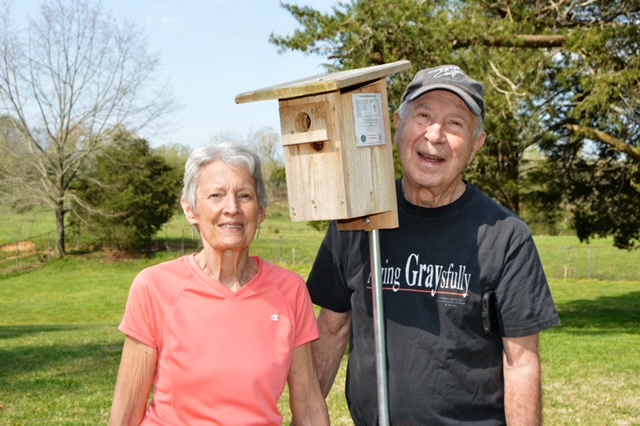From press release:
COOKEVILLE — Peering inside the small wooden boxes on their weekly rounds at Cane Creek Park, Bill and Jane Gray anticipate sweet discoveries. First, they notice bits of straw, grass or pine needles. Later, a full nest. Then, an increasing number of small blue eggs. And finally, baby bluebirds.
The process repeats two or three times between late March and August, with Bill opening the 10 boxes, which rest atop metal poles, and Jane taking notes and pictures. They report their observations to the Cookeville Bluebird Club, of which they are members.
“We see the progress,” Jane said. “When the baby birds have fledged, we clean the nests out so the box will be ready for another one.”
The Grays are two of several monitors from the Cookeville Bluebird Club looking out for these charming birds with the blue and orange feathers. Other monitors do the same at Dogwood Park, checking the four boxes there. The boxes at both parks are monitored twice per week in an effort to ensure successful nesting and, thus, an increase in the local bluebird population.
“Bluebirds need our help,” Don Hazel, president of the Tennessee Bluebird Society, said of the cavity-nesting birds. “Non-native starlings and house sparrows aggressively take over most natural holes in trees, and without nest boxes, bluebirds have a hard time competing for available natural nest sites.”
In early 2020, Hazel, who lives in Fairfield Glade, was invited to speak about bluebirds at a local garden club meeting. Soon after, members contacted Cookeville Leisure Services about placing nest boxes at Cane Creek Park and Dogwood Park.
“Nest boxes in public parks not only help the bluebirds, but they allow people to observe these beautiful native birds,” Hazel said.
Following a successful bluebird season, the Cookeville Bluebird Club was founded.
The 1 ½-inch, double-thick entrance hole in a bluebird box keeps starlings and other predators out, and the lack of a perch discourages sparrows. Other features include an inside screen so the baby birds can climb out, roof overhang for protection from sun and rain and, most importantly, a way to open the box to check on problems and clean out old nests. Bluebirds lay four to six eggs and raise two to three broods per year.
The Grays are happy to do their part for the bluebirds — but they get something out of it too.
While making their way around the lake trail at Cane Creek Park, they hear birds singing, leaves rustling and water rippling. They see turtles resting on logs and squirrels scampering up trees. They pass by morning joggers, couples walking dogs, and mothers pushing babies in strollers. They observe disc golf players throwing their discs and fishermen reeling in their catches.
So many happy, leisurely sights.
As Bill and Jane approach a nest box, they watch for signs of bluebird activity. Maybe they’ll see a tiny head peeking out of the hole. Maybe they’ll see the feathered occupant perched on top of the box or in a nearby tree, ready to swoop down for an insect meal.
“We’re always interested in seeing the bluebird itself,” Bill said.
Looking inside the box, the Grays are delighted to see something new each week.
“The bluebird eggs are a pretty blue,” Jane noted.
Sometimes they’ll discover that a tree swallow has inhabited the box — and that’s okay.
“We’d rather have bluebirds, but we don’t disturb the tree swallows,” Jane said.
However, nests of non-native species like house sparrows, which can be harmful to bluebirds, are removed.
This is the second year that Bill and Jane have monitored bluebird boxes at Cane Creek Park. They are pleased by the results so far and believe this project benefits visitors at both parks.
“Hopefully, they are seeing more bluebirds on their walks,” Bill said.
While bluebirds are tolerant of people, park visitors should avoid disturbing the boxes.
The Grays also encourage more people to join the Cookeville Bluebird Club and place nest boxes on their properties, as they and other club members have done. That way, more bluebirds will have homes in Cookeville. Anyone interested should email cookevillebluebirds@gmail.com.
Hazel said the club is already monitoring 49 nest boxes this year, including the 10 at Cane Creek Park and four at Dogwood Park. Last year, they fledged more than 90 baby birds.
“The Cookeville Bluebird Club is only one year old but doing a fantastic job,” he said.
The bluebirds can’t complain.

